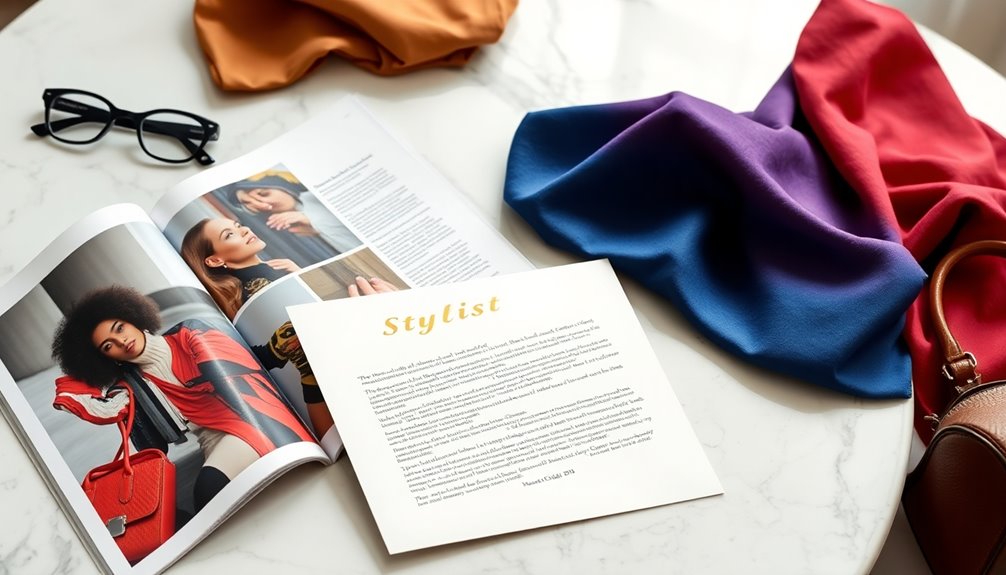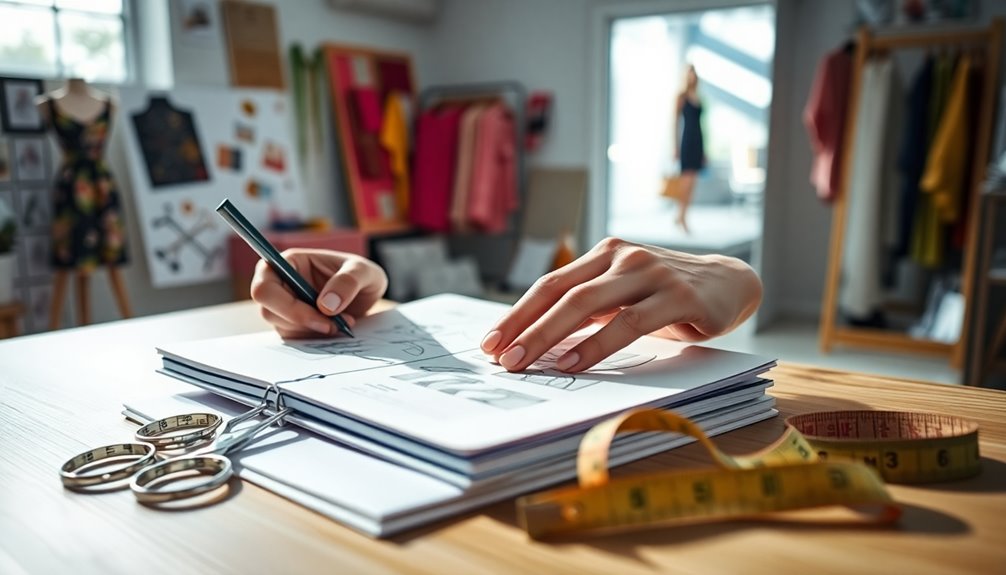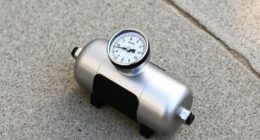Working in fashion and beauty involves different focuses and skills. In fashion, you'll deal with design, production, and seasonal collections, requiring creativity in garment construction and trend analysis. On the other hand, beauty emphasizes product development, research, and compliance, with a stronger emphasis on client interaction and communication skills. Fashion launches are quick, while beauty products take longer to develop, often needing extensive market research. Both industries demand innovation and awareness of sustainability trends, but their operational rhythms vary. Curious about how these differences affect your career choices? There's more to explore about each industry's unique landscape.
Key Takeaways
- The fashion industry focuses on seasonal collections and rapid prototyping, while beauty emphasizes extensive research and compliance for longer product development timelines.
- Fashion roles often prioritize design and marketing, whereas beauty careers emphasize product formulation and client engagement skills.
- Production processes in fashion are unpredictable and require tight schedules, while beauty follows more consistent timelines with strict adherence to launch dates.
- Sustainability trends differ, with fashion pursuing circular approaches and eco-friendly materials, while beauty focuses on innovative ingredients and sustainable packaging.
- Collaboration with diverse teams is crucial in both industries, but fashion requires more emphasis on creativity, while beauty prioritizes consumer education and empathy.
Industry Structure Comparison
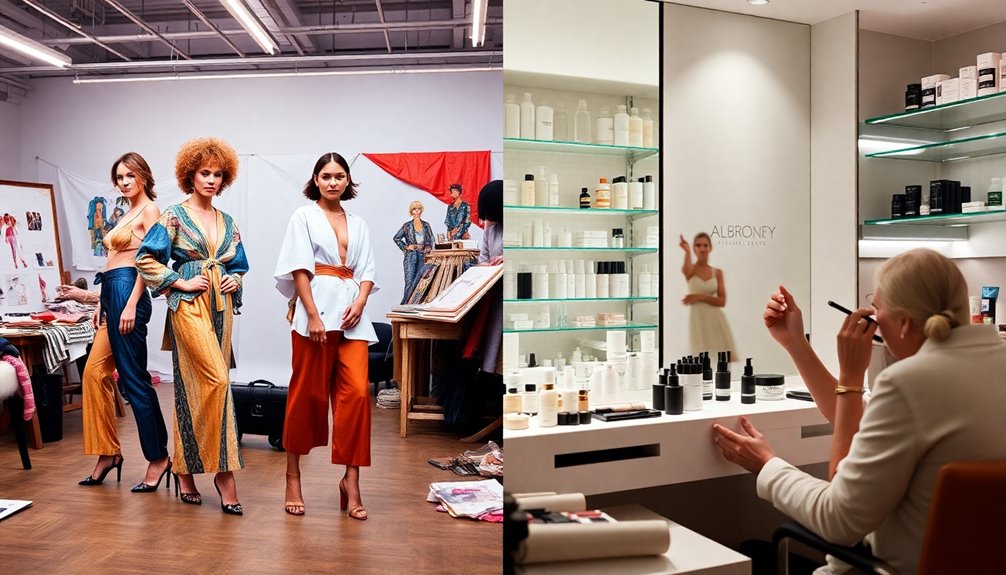
When comparing the industry structures of fashion and beauty, you'll notice distinct differences in hierarchy and operational dynamics.
The fashion industry operates on four main levels: raw material production, fashion goods production, retail sales, and advertising. You'll find various interdependent sectors, from designers to manufacturers and retailers, all working together. Leadership roles often include creative directors and executive managers, with a clear chain of command to facilitate decision-making. The fashion industry is a significant employer in the global economy, which underscores its importance in providing jobs across multiple sectors.
In contrast, the beauty industry features a more complex organizational structure. Companies like L'Oréal have multiple brand divisions and geographic zones, with an Executive Committee managing operations across these divisions.
Here, the Board of Directors not only advises but can also take on executive roles, ensuring both global strategies and localized approaches.
While the fashion industry may lean toward a hierarchical or functional structure, the beauty industry emphasizes decentralized operations. Local teams are empowered to adapt products and marketing strategies to regional consumer needs, creating a more flexible business model.
This responsiveness is crucial for meeting the demands of diverse markets, making the beauty industry uniquely structured compared to the more traditional fashion hierarchy.
Product Development Processes
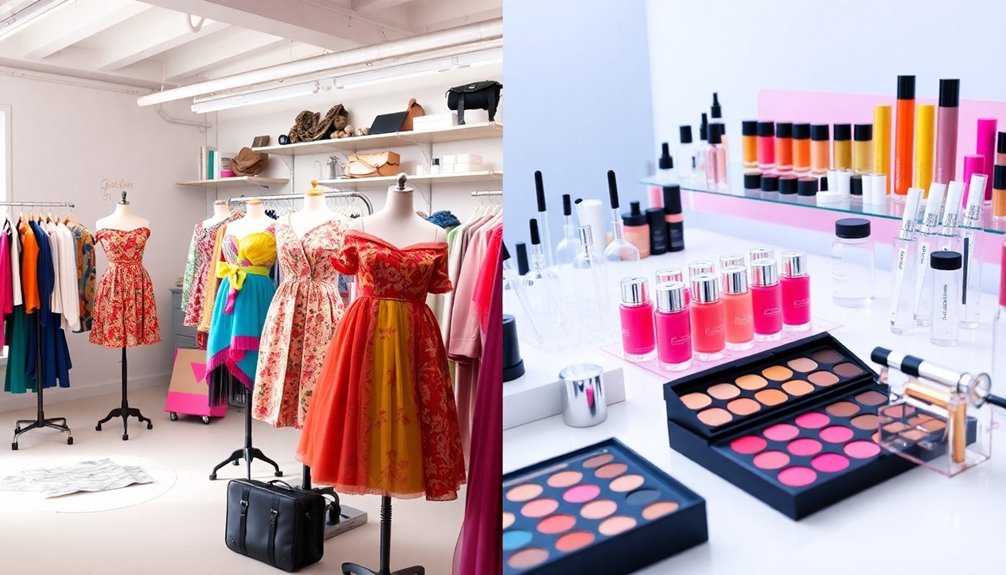
In the world of fashion and beauty, product development processes are essential for bringing creative ideas to life.
In fashion, you start with design and conceptualization, creating sketches and understanding trends that resonate with your target market. Using mood boards helps visualize your ideas, and collaboration with design consultants can refine those concepts. Additionally, the sourcing of fabrics plays a crucial role in ensuring that designs align with market demands and quality expectations.
Next, you move to product development and prototyping. Here, you create technical drawings, size charts, and prototypes to test fit and construction. Several rounds of sample-making occur until you finalize the design.
In beauty, the process begins with concept and market research, focusing on consumer needs and market trends. You decide on product positioning and analyze competitors to identify gaps.
Then comes formulation and development, where you select ingredients and ensure compliance with regulations. After creating prototypes for testing, you finalize the recipe.
Substantiating raw materials and packaging follows, as you choose suppliers and evaluate quality.
Throughout both industries, effective communication and operational oversight ensure that your creative vision transforms into a tangible product ready for market launch.
Career Roles Overview
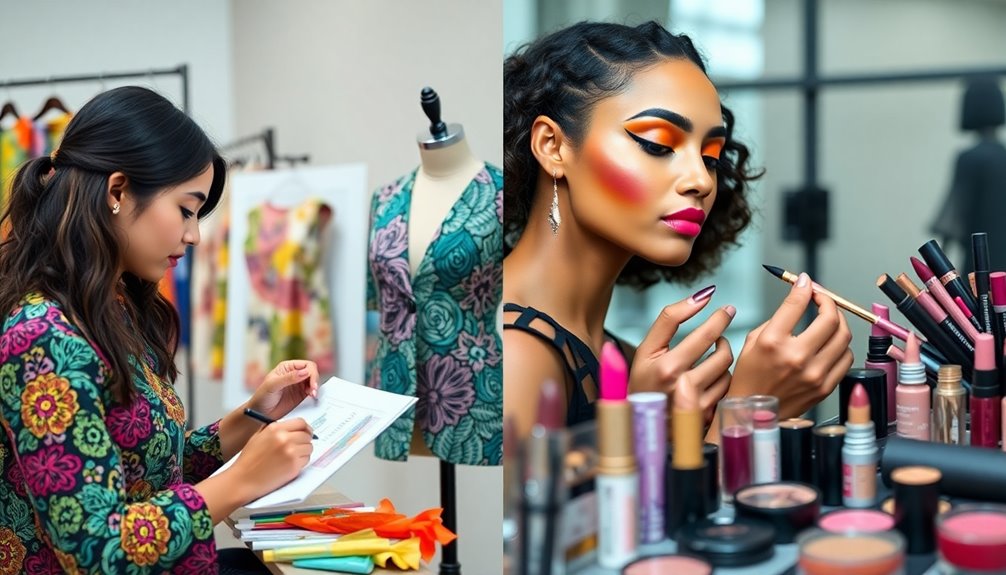
Throughout the fashion and beauty industries, a diverse range of career roles exists, each offering unique opportunities and challenges.
In fashion, you might find yourself as a fashion designer, creating innovative garments and accessories while collaborating with marketing teams. As a fashion merchandiser, you'd focus on stock management and pricing strategies to ensure profitability, analyzing trends and consumer behaviors. A fashion marketing manager plans campaigns that build brand awareness, utilizing social media and events to maximize sales, which often requires strong analytical skills to assess campaign effectiveness. Understanding retirement savings plans can also provide financial stability as you navigate your career.
In the beauty industry, roles vary from estheticians, who specialize in skincare treatments and require specific licensure, to beauty consultants assisting customers with product choices in retail settings. The income for beauty professionals, such as hair stylists, typically ranges from average annual income $30,000 to $50,000, depending on location and tips.
If you prefer management, a salon and spa manager oversees business operations and staff training, often needing a background in cosmetology. Alternatively, as a beauty editor, you'd create content for publications while staying on top of industry trends.
Each role demands a unique skill set, whether it's creativity, analytical thinking, or communication, allowing you to carve your niche in either industry and contribute to its dynamic landscape.
Work Processes and Schedules
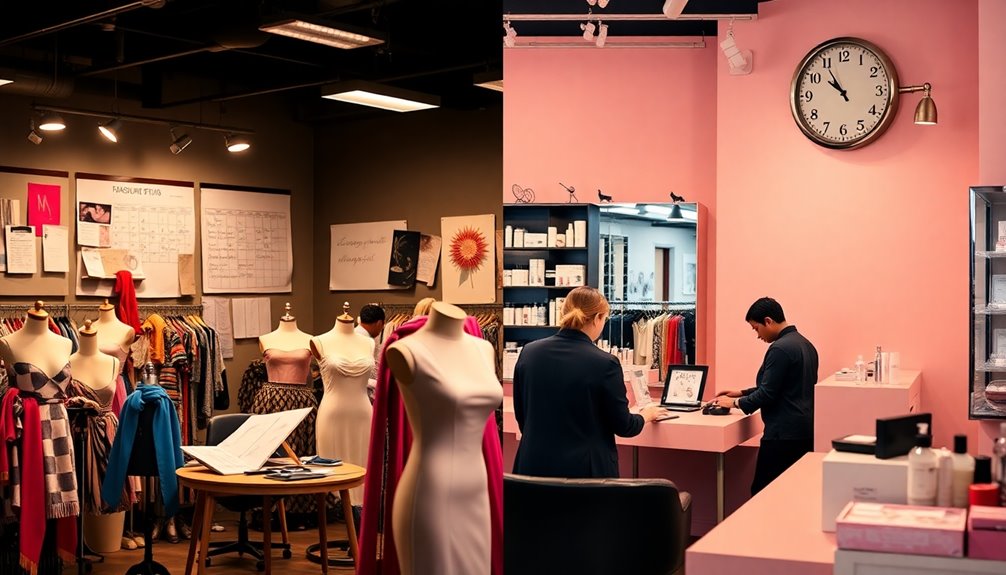
Understanding the nuances of work processes and schedules is vital for anyone considering a career in fashion or beauty. Many professionals in these industries work long and irregular hours, often including weekends and evenings to meet deadlines and attend events. However, those who are passionate about fashion or beauty understand that these unconventional paths to success can be rewarding and fulfilling. By staying adaptable and dedicated to their craft, individuals can thrive in these fast-paced and competitive fields.
In fashion, you'll often engage in distinct phases like pre-production, garment construction, quality control, and delivery. Your schedule can be tightly packed, especially during seasonal launches, requiring hours spent on design revisions, fabric sourcing, and fittings to ensure everything aligns with the latest trends and quality standards. The importance of pre-planning in fashion helps streamline the garment production process and enhances communication with manufacturers.
On the other hand, working in beauty involves processes such as raw material acceptance, mixing and filling, appearance testing, and shipment. Here, you'll focus on ensuring ingredient compatibility and product consistency, often adhering to strict timelines for product launches. Your days might include meticulous inspections and batch testing, with schedules influenced by production demands.
Both industries require flexibility, but fashion tends to follow more unpredictable timelines, especially around shows and events.
In beauty, the structure might be more consistent, driven by production cycles. Understanding these differences can help you decide which environment suits your work style best.
Required Skills and Training

To thrive in the fashion or beauty industries, you need a diverse set of skills and training tailored to each field. In fashion, understanding garment construction, fabric manipulation, and patternmaking is essential. Proficiency in sewing and crafting techniques, along with CAD skills for precise design execution, will set you apart. Mastering draping is another key aspect that brings your designs to life. Additionally, a commitment to sustainability practices is becoming increasingly vital in modern design approaches.
Creativity and innovation are crucial in both industries. You'll need to envision new patterns and styles, showcase artistic skills like sketching and color matching, and stay updated on the latest trends.
In beauty, effective client communication, empathy, and active listening are vital for understanding client needs and providing exceptional service.
Educational pathways vary: aspiring fashion designers often attend specialized schools, while beauty professionals typically earn a state license in cosmetology. Knowledge of sanitation, safety, and sustainable practices is also crucial in both fields.
Additionally, understanding business skills like marketing and financial management will help you navigate the competitive landscape, ensuring you not only create but also succeed in your chosen career.
Industry Trends and Influences

The dynamic nature of fashion and beauty industries means you must stay on top of the latest trends and influences shaping each field.
In fashion, sustainability is a key focus, with a rising demand for circular fashion, biodegradable materials, and lab-grown fabrics. As younger, eco-conscious consumers drive these changes, you're likely to see more brands adopting ethical practices. Additionally, the increased use of biodegradable materials is becoming essential for brands aiming to reduce their environmental impact. Many celebrities, such as Nikki Reed and Ian Somerhalder, are also promoting sustainable lifestyles, influencing consumer choices. Furthermore, the growing interest in organic tea reflects a similar trend towards sustainability in other industries, including fashion and beauty. The emphasis on nutrient retention in food parallels the fashion industry's push for sustainability and health-conscious practices.
Technological integration is transforming fashion as well, with smart clothing becoming more prevalent. Collaborations between tech companies and fashion brands are pushing the boundaries of what's possible, expanding the global smart clothing market significantly.
In beauty, the emphasis is shifting towards preventative skin care, with consumers prioritizing skin health and effective ingredients over mere aesthetics. The influence of celebrity endorsements has also shaped beauty trends, as seen with stars promoting effective skincare.
Management and Application Differences
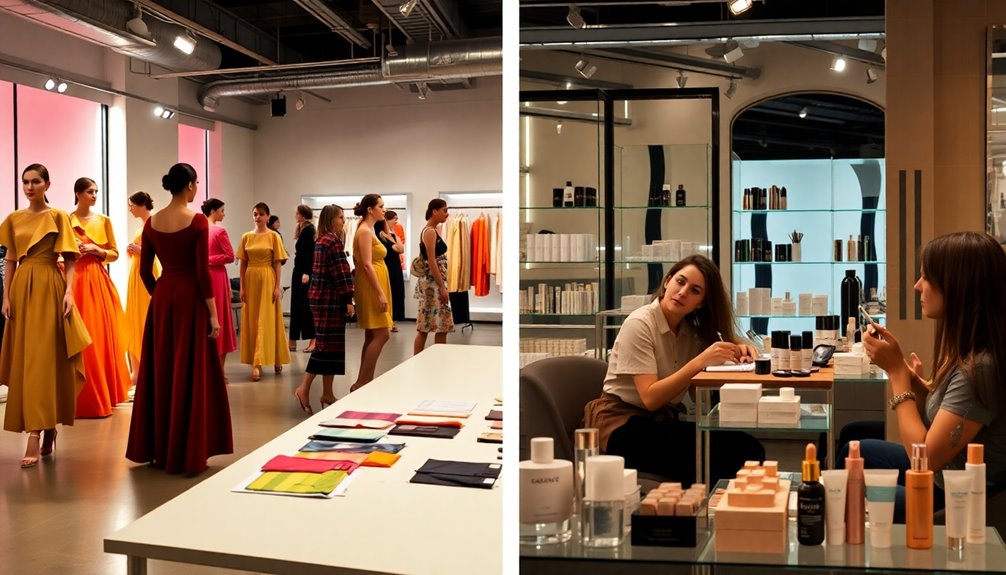
Navigating the management and application differences between fashion and beauty reveals distinct processes vital to each industry's success.
In fashion, you'll focus on design teams crafting prototypes and managing seasonal collections. You'll deal with fabric sourcing, negotiating prices, and ensuring quality through stringent control measures. The production process emphasizes mass manufacturing, necessitating ERP systems to streamline operations. Efficient production management is essential to ensure timely deliveries and maintain brand reputation in the competitive fashion landscape.
On the other hand, beauty revolves around long research and development phases, where you formulate products and design packaging. Ingredients must meet regulatory standards, and quality assurance is crucial, as you'll conduct extensive testing for safety and efficacy. Regular use of effective ingredients like glycolic acid can enhance product performance and consumer satisfaction.
While fashion often releases collections seasonally, beauty products require more frequent launches, which means you'll need to manage inventory carefully to keep up with consumer demand.
In both sectors, supplier relationships matter, but the focus differs; fashion emphasizes fabrics while beauty prioritizes ingredient sourcing.
Distribution also varies, with fashion targeting stores and beauty leveraging multiple channels, including online platforms. Understanding these management and application differences helps you navigate your career path effectively in either industry.
Product Launch Timelines
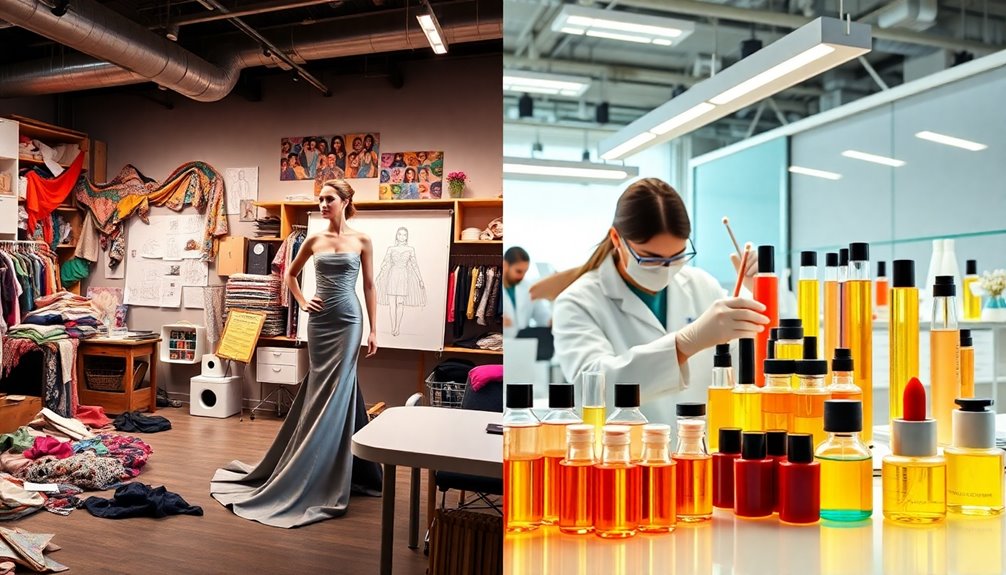
Product launch timelines in fashion and beauty differ significantly, impacting how brands strategize their releases.
In fashion, you typically work with seasonal launches. Depending on the hemisphere, these launches align with Spring/Summer or Autumn/Winter, requiring you to consider consumer interest and wardrobe updates. The development process can take up to six months, involving design submissions and fabric sourcing. You must also account for wholesale marketing, allowing 1-2 months for engaging retail buyers before placing orders. Additionally, understanding the importance of timing in fashion launches is crucial for aligning your products with consumer demand.
In contrast, beauty product launches often extend over 12 to 18 months, encompassing pre-launch, soft launch, and post-launch phases. You'll find that research and development is crucial; it involves extensive product testing and formulation, which can complicate timelines.
Engaging influencers and executing effective marketing strategies are vital during the launch phase, as they help build brand awareness and attract consumer interest.
Both industries require timely coordination with retail and distribution channels, but the timelines differ greatly. In fashion, you focus on seasonal rhythms, while in beauty, you're more concerned with longer, multi-phase launches.
Understanding these differences can help you navigate your role effectively in either field.
Sustainability in Both Industries

In today's world, sustainability is becoming a key focus for both the fashion and beauty industries, as brands strive to minimize their environmental impact.
In fashion, you're likely to see brands adopting eco-friendly materials like organic cotton, recycled polyester, and natural fibers such as linen and bamboo. They're focusing on zero-waste production methods, using water-efficient technologies, and implementing natural dyes to reduce waste. Additionally, the industry is facing barriers to adoption that challenge the widespread implementation of sustainable practices.
Circularity and recycling practices are crucial, with brands upcycling materials and collaborating on sustainability initiatives.
In the beauty sector, brands are incorporating innovative, eco-friendly ingredients while emphasizing sustainable packaging. Many encourage consumer engagement through educational campaigns, helping you understand the environmental impact of your choices.
The EcoBeautyScore, for instance, provides a clear environmental score for cosmetics, promoting awareness.
Both industries are integrating ecodesign at every stage, driving toward a net-zero future by 2050. They focus on decarbonizing supply chains and minimizing transportation emissions.
Frequently Asked Questions
What Are the Salary Ranges for Fashion Vs Beauty Careers?
When you look at salary ranges, fashion careers generally pay higher than beauty careers.
Fashion designers average about $83,650 annually, with entry-level positions starting around $37,000. Fashion industry job salaries can vary greatly based on experience, location, and the specific company. Those with years of experience and a strong portfolio may earn upwards of $130,000 or more. Additionally, high-end fashion designers working for prestigious labels or with a celebrity clientele can command even higher salaries. Overall, the fashion industry offers a wide range of earning potential for talented and ambitious professionals.
In contrast, the beauty industry averages about $38,510, with makeup artists earning around $41,026.
Top earners in beauty can make up to $48,500, while certain fashion roles, like design directors, can reach up to $177,560.
How Do Internships Differ in Fashion and Beauty Industries?
Internships in fashion and beauty differ significantly in responsibilities and environments.
In fashion, you'll assist with design, manage wardrobe pieces, and participate in photo shoots.
Beauty internships focus on product development, project management, and supplier coordination.
Compensation varies too; fashion internships are often unpaid, while beauty roles tend to offer better pay and benefits.
Both fields require specific skills, but you'll find the pace and tasks vary greatly between them.
What Are Common Career Advancement Paths in Both Sectors?
In both sectors, you'll typically start with entry-level positions, where you'll learn from experienced professionals.
As you gain skills, you'll advance to mid-level roles, taking on more responsibilities and managing teams.
After several years, you can reach senior positions, which require extensive experience and leadership abilities.
Ultimately, executive roles await those with a strong vision and strategic mindset, offering higher salaries and the chance to shape the industry's future.
How Do Networking Opportunities Compare in Fashion and Beauty?
When it comes to networking opportunities, both fashion and beauty offer unique avenues. You can attend industry events like fashion shows or beauty trade shows to meet key players.
Building genuine relationships is crucial, so follow up with contacts. Utilize social media platforms to showcase your work and engage with professionals.
Strategic collaborations with others in the industry can enhance your portfolio and open doors for future opportunities.
Networking's all about connection and collaboration!
Are There Significant Differences in Workplace Cultures Between the Two Industries?
Yes, there are significant differences in workplace cultures between fashion and beauty.
In fashion, you might find a more centralized, high-pressure environment that emphasizes creativity and strict deadlines.
Conversely, beauty often features a decentralized culture with more collaborative dynamics.
You may feel a difference in communication styles, too, as beauty's frequent product launches can foster a more supportive atmosphere.
Conclusion
In summary, while both fashion and beauty share creative elements, they differ significantly in structure, processes, and roles. You'll find that fashion demands a keen eye for trends and visual storytelling, whereas beauty focuses on product formulation and consumer needs. Understanding these distinctions can help you choose the right path for your career. Whether you lean towards the runway or the makeup counter, both industries offer exciting opportunities for creativity and innovation.


